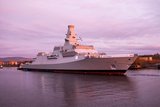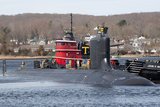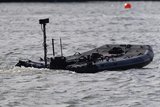Israeli navy gets Guardian Gate
Halo Maritime Defense Systems (HMDS) has installed a fully automated marine gate at an Israeli naval base, the company announced on 26 May.
The HMDS Guardian Gate spans the full length of the opening to the base from breakwater-to-breakwater, and can be retracted with a single button to allow vessels to pass.
The barrier has been under development for two years with help from the Ocean Engineering Program at the University of New Hampshire and the US Navy. According to the company, it has a 15-year design life and has been validated in independent, fully instrumented crash testing by the US navy.
The HMDS Guardian Gate can be installed at ports, harbours, nuclear power plants, oil and gas assets and other sensitive waterside infrastructure to prevent the access of unauthorised persons and vessels into protected areas.
Brendan Gray, president, HMDS, said: 'Normally, the waterside opening to a base like this would be secured with surveillance cameras and possibly patrol boats but never before with a proven, automated 24/7 protective gate.
'The marine gate provides ease of access while offering unparalleled security and at significantly less life-cycle cost than the alternatives with a return on investment of less than 2 years.'
Tom Ridge, advisor to HMDS, said: 'I am proud to be working with a firm that has developed what I believe to be the definitive answer to addressing the threats posed by small boats to strategic and sensitive waterside assets around the globe – military, commercial and even residential.'
More from Naval Warfare
-
![Hanwha wins Australian government approval to increase its stake in Austal]()
Hanwha wins Australian government approval to increase its stake in Austal
The contract would mean the two shipbuilders can collaborate strategically and enhance shipbuilding capabilities in Western Australia.
-
![Royal Australian Navy sizes up modernisation plans for new and existing capabilities]()
Royal Australian Navy sizes up modernisation plans for new and existing capabilities
The Australian navy is pushing ahead with its efforts to modernise its workforce and capabilities while balancing risky submarine upgrades, ageing Collins-class boats and a shrinking minehunter fleet. Head of navy capability RAdm Stephen Hughes updated Shephard on the force’s progress.
-
![UK to join US Navy’s Virginia-class submarine assembly effort to speed up construction]()
UK to join US Navy’s Virginia-class submarine assembly effort to speed up construction
The expansion of the Virginia-class submarine construction to UK shores could accelerate the project as US shipbuilders continue to fall short of delivery goals.
-
![US Navy seeks new sensors for the CH-53K King Stallion heavy-lift helicopter]()
US Navy seeks new sensors for the CH-53K King Stallion heavy-lift helicopter
The US Navy intends to publish a draft request for proposals in Q2 2026 and conduct an open competition for the supply of new electro-optical and infrared capabilities for the CH-53K heavy-lift helicopter.
-
![NATO naval exercises map out future USV requirements but raise questions on acquisition]()
NATO naval exercises map out future USV requirements but raise questions on acquisition
Uncrewed surface vessels have shifted from a desirable capability to a critical one for navies. But should these systems be bought outright, rented as a service or rapidly built using commercial off-the-shelf components?























